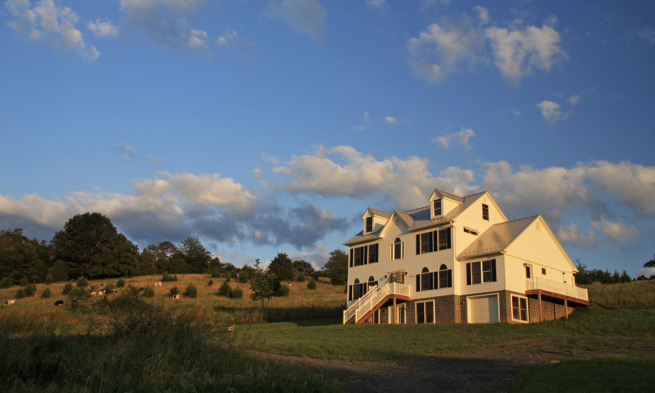Is green living practical?
Being the Change
Zach Fettig ('06) proves that eco-friendly living can be comfortable
By Tyler McAvoy ('11)
Many view the terms "green-living" and "life of luxury" as opposite from each other as hot and cold. Though many of us want to live a greener lifestyle — and would love to have houses that are practical and eco-friendly — we find that most of the time, green-housing requires deep pockets, compromising spaces and out of the ordinary house designs.
Or maybe not.
Imagine a beautiful three-story house, in the middle of a lush, green field. Its white walls shine, untouched by the years of harsh weather in the valley. On its gabled roof solar panels glisten, and a bevy of white guttering runs from the edge of roof into the bowels of the basement.
It's a house very much like any house you've seen out in the middle of the country, complete with a garden, an exposed stone basement and a flight of stairs leading to the front door.
But it's not an ordinary house at all.
Freedom House, completely independent
Freedom House, a project spearheaded by JMU alum Zach Fettig ('06), was designed and built to be net-zero efficient — that is producing as much energy as it uses. Freedom House gets its name from being completely independent — free — from any electrical or water utility grid. Though the concept isn't new, Fettig's innovative approach is. Freedom House is a normal house.
"I really wanted to show that sustainable housing can be comfortable and affordable." says Fettig. "True green technologies can be used and constructed affordably."
The idea to create a comfortable net-zero house came from studying different energy efficient materials while Fettig was an Integrated Science and Technology major at JMU. Realizing that there hasn't yet been a commercially viable example of what green living can look like, he decided to start his own company to promote the idea.
Building a company to champion green living
Taking out a personal risk loan after graduation, Fettig devoted the next three years to building Freedom House, the flagship of his company Shenandoah Sustainable Technologies LLC.
"It's a paradigm shift in how we think and use green resources," Fettig says.
Using innovations such as rainwater collection, argon filled windows, heat-absorbing tile and an ingenious solar water heating system, Freedom House is completely energy self-sufficient. Even the appliances, such as the stove and refrigerator, are some of the most efficient on the market.
But the best thing about Freedom House? No creature comforts are spared.
Josh Kelaher ('11) is an intern for Fettig's company and currently lives in Freedom House.
"This place is just like any other house, and requires maintenance just like any house does," says Kelaher. "Living here just requires some general interest about green living."
Innovative approaches
While the house's construction and systems are state-of-the-art, the core success of Freedom House is its innovation. The house is constructed with the flat sides of the roof facing north and south to maximize the sun's energy with solar panels and heat-trapping windows. Interior heat-trapping tile absorbs energy from the sun during the day and releases it at night, allowing minimal use of other heating systems.
The water heating system lies on one of the gables as well, using the photons from the sun to warm the water, even on the coldest winter days.
Having such an efficient heating system allows the energy that normally would be relegated to heating the water and home to be used for other more important things such as electricity at night or backing up the geothermal systems.
In other words, the house uses all of its pieces of efficient equipment in harmony to make an even more efficient structure overall, achieving a nearly perfect net-zero energy balance.
"It's interesting living here because we become a much smaller blip on the radar in terms of energy consumption," says Kelaher. "It becomes a game. You start looking for ways to make a smaller impact day to day."
Shenandoah Sustainable Technologies LLC is currently seeing interest all over the state for various green housing projects, utilizing many of the systems found in Freedom House. Though Fettig credits much of his success to his undergraduate studies at JMU, he finds that ISAT students, and interns for his company, like Kelaher, are the biggest asset.
"The most important resource is the students that help in everything," Fettig says. "JMU creates critically thinking people, which is important to every part of green building, whether it be engineering the systems or building the house."
